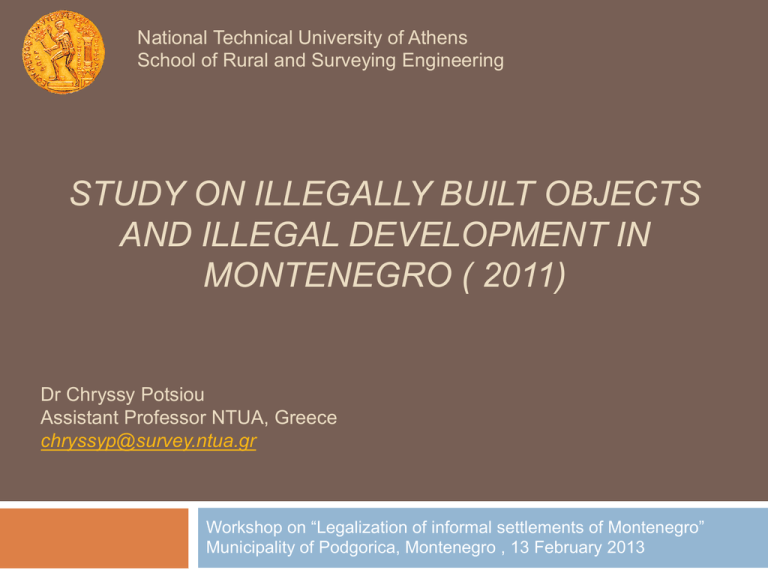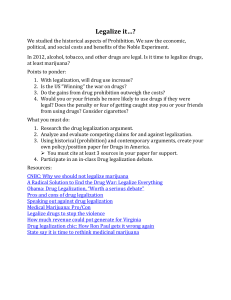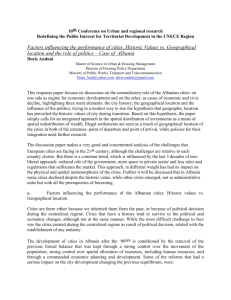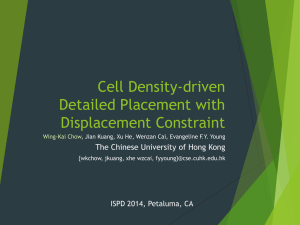presentation of Study on Illegally Built Objects an Illegal
advertisement

National Technical University of Athens School of Rural and Surveying Engineering STUDY ON ILLEGALLY BUILT OBJECTS AND ILLEGAL DEVELOPMENT IN MONTENEGRO ( 2011) Dr Chryssy Potsiou Assistant Professor NTUA, Greece chryssyp@survey.ntua.gr Workshop on “Legalization of informal settlements of Montenegro” Municipality of Podgorica, Montenegro , 13 February 2013 objectives provide an analysis of the situation (origin, causes, impacts, size of the problem, type) investigate the policy framework, strategy and tools used for the legal integration give recommendations for improvements and solutions in order to unblock the real estate market general information Constitution: Montenegro is an “ecological” country destructive earthquakes & other natural hazards population: various ethnic groups UN: “improving the plight of Roma is one of the toughest challenges” 1993: 2/3 of the Montenegrin population lived below the poverty line currently: service-based market economy; tourism; foreign investment significant differences in the extent of poverty citizens of Montenegro are emotionally attached to land; this resulted in a weak land market informal development “first generation” since the era of socialism over 6000 households, many of which are Roma, live in substandard dwellings > 80% of the houses and apartments are “illegal” constructed either completely without a building permit on state land or beyond the specifications of the permit ~ 130,000 illegal buildings (source: UNDP) - vary in terms of size, type, standard, location, use - mainly concentrated in small and medium settlements causes (1/2) poverty, migration, inadequate social/affordable housing policy inability & unwillingness to pay only 20-30% can afford property taxes; the rest cannot afford or do not trust the state and the local government natural disasters (earthquake) privatization of land to the citizens? restitution of property rights (2004)? weak property rights insufficient credit system incomplete cadastral maps (~65%) no information about the registered private properties complicated procedure for refugees & minorities causes (2/2) out-dated, centrally driven and bureaucratic planning to “control” development numerous field inspections, lack of serviced land, funds & personnel expensive and cumbersome procedures for building permits weak professional ethics misuse of power speculation and corruption ignorance of existing regulations local and international market pressure inconsistent policies & illegal buildings (1/2) registration of illegal constructions (IC): - in the past IC were registered as an encumbrance, prerequisites: Montenegrin citizenship & a use right on the land and the owners are expected to pay taxes - now, only the buildings with a permit to use are registered weak tenure / Privatization / restitution (2004): emphasis is given on the cadastral mapping and not on the privatization of land/ citizenship law of 2008 until today cooperatives still exist in the rural areas – productivity problems since 2009 foreign property owners are offered long-term leasing instead of ownership rights Expropriation: Unclear; fair compensation? inconsistent policies & illegal buildings (2/2) until 2008 both rural houses and agricultural facilities did not need a construction permit (only a letter of acceptance ) now, all are considered to be illegal - serious problems in the municipalities & delays to the WB rural investment projects unrealistic property taxation: Although property taxes were not affordable, in 2008 taxes have been raised even more Property registration, transfer and mortgage, as well as access to investment and development projects in the rural areas should be treated and facilitated independently of any planning needs, informalities or illegalities Increase of tax rate on real estate transfers may cause a negative impact on real estate market. weaknesses in the property market (1/2) authentication of signatures on the sale agreement is/was done by the jurisdiction of basic courts, as notaries did not exist until 2011 basic courts are usually overloaded by a variety of cases access to court records to check if the property has been sold but not yet registered in the cadastre is impossible entrance to the cadastral records is only possible by the name of the owner not by the object; this requires more effort to identify the particular property under sale weaknesses in the property market (2/2) cadastral offices are inefficient and delay the registration process the % of abandoned & of state land is great unregistered illegal constructions don’t pay taxes banks do not take mortgage on illegal buildings unless the applicant owns the land and the value of the land covers the loan collection of maintenance fees in the multi-family buildings is poor (only 10-14 per cent of owners pay) delays to investment projects weaknesses in planning & building permitting (1/2) highly centralized, expensive and absolutely inflexible procedures the current parcel arrangement in the field does not match with the existing plans investors usually undertake the planning and utility infrastructure and connection costs on-site inspections (for spatial protection, urban planning, construction of structures, ecological); expensive / inspectors are vulnerable to bribing WB ranking: at 173rd of 183 economies on the ease of building permits weaknesses in planning & building permitting (2/2) a “pro-growth” approach aiming to simply “facilitate” development, taking into consideration a number of issues like the economic situation of the citizens, the existing private property rights, the market needs, the lack of reliable plans, of personnel and of funds, may be adopted automated procedures and mechanisms should be adopted for environmental protection and development monitoring environmental, social & economic impacts (1/2) inadequate utilities & disaster risk prevention and management ~10% of the territory has problem with seasonal supply of fresh water ; 6 municipalities no energy supply ; 8 municipalities no waste collection; discharge of waste waters in septic systems and pollution current challenges: planning for the waste management locations, resolving land expropriation issues, and issuing permits for 4 more landfills Roma settlements are most socially marginalized environmental, social & economic impacts (2/2) sleeping capital: no legal ownership rights and/ no access to credit or to the real estate market Especially in the rural areas people found themselves in the unpopular situation to be considered illegal retroactively. innovative and increased citizen involvement, participation may replace the state in some tasks; traditional tasks carried out by the local government may be transferred to the citizens current trends in dealing with informal settlements (1/2) “dead capital” invested in illegal constructions should be activated for the benefit of the national economy & general prosperity; strict environmental regulations and constitutional restrictions put the brakes on economic growth access to land & ownership should be affordable, procedures must be simplified any tool used to improve the existing situation should not create homeless people any demolition should be applied exceptionally always at an early stage, with transparency, providing for judicial appeals legalization procedure should be inclusive, clear, cheap and attractive to all current trends in dealing with informal settlements (2/2) legalization should be accompanied with affordable and flexible planning (with minimal norms & standards) and building permitting to facilitate growth special measures for Roma seismic vulnerability controls are mainly intended for illegal structures of professional use that require a special operation license, and constructions of all uses that accommodate large accumulations of people (e.g., hotels, restaurants) the state should give priority to legalize / clear out the ownership rights; planning and building informalities should not be a prerequisite for issuing the ownership title comments on the legalization law (1/13) “those built after 2008 should obligatorily be demolished” adoption of such strict deadlines without making any serious system reforms simply create a new generation of informal settlements legalization is planned to fit with the practices, policies and legal framework of a highly controlled economy empowerment of ownership rights and operation of property market is not within the first priorities of this law. Legalization may only take place after fulfillment of city plans, all kinds of controls and payment of all costs, taxes and fees; moreover, legalization should follow technical improvements if needed. Citizens are expected to get bank loans for all the above expenses and the process of legalization is expected to go on for at least for 10 years comments on the legalization law (2/13) it is good to create job opportunities; however, emphasis should be placed on professional ethics, as the concept of legalization is not to keep engineers busy, neither to make the procedure long. Such reform projects should be cheap, inclusive and finish in limited time it seems complicated and rather awkward to adopt different legalization approaches for the different locations or types of informal settlements, especially in a country as small as Montenegro. There is a risk that pilot legalization projects may delay the legalization progress and its expected benefits enormously comments on the legalization law (3/13) “...in the past governments asked professionals: what needs to be done? How much it will cost? How long it will take? Today, many governments tell the professionals: this is what needs to be done; this is how much money you have; this is when it must be completed” From this point of view most of the detailed requirements for legalization may be minimized, made more affordable or postponed for a post-legalization stage annual property taxes that will be applied after recognizing and registering the ownership rights may be scaled according to the market value of the real estate (location is always an important factor which together with other parameters like construction quality, age, etc, determine the market value). comments on the legalization law (4/13) market mechanisms will soon unlock the potential value of each location, while property owners may then consider several options to satisfy their housing needs. The state will benefit from the operation of the property market. areas of particular natural beauty may be pre-selected and delineated on orthophotos in order to be protected; in any case such areas should be limited in number and size most likely only the upper low and middle income state employees and those working at the most stable private companies will qualify for such bank loans; besides it is not common practice that citizen are forced to get bank loans in order to pay taxes or communal fees comments on the legalization law (5/13) moreover, it is not likely that the state will subsidize the utility bills; this may happen in the case that utility companies are state enterprises but this also is not a common practice in the free market economies government should not get involved in agreements with the private sector and Montenegrin engineers about fees for service, too; fees should not be fixed; the market is expected to determine fees. before legalization, it would be much preferable to separate ownership rights from any obligations or any kind of permits like construction and occupancy permit, operational permits in case of commercial buildings and planning permit / requirements, and to have: comments on the legalization law (6/13) as phase A: orthophoto production; identification of (a) those areas of special interest where special policy approaches will be applied, and of (b) illegal zones within which a unified, simple and quick legalization will take place and where further construction may be permitted (with minimum norms and standards) comments on the legalization law (7/13) acceptance of the existing built-up situation as the detailed city plan; few constructions that do not fit will be demolished; affordable privatization of land (e.g., for first residence, up to a minimum plot size) accompanied with a simple survey of the property on the orthophotos including the footprint of the building and its basic characteristics (area size, floor number, construction type, photo) , and title issuing. Purchase of land at market value in other cases; alternative possibility for long term leasing in case people cannot afford the prices comments on the legalization law (8/13) registration of property rights to the cadastre and immediate legalization (permit for integration of these building into the property market); obligatory controls for seismic vulnerability and other requirements in case of commercial multi-family blocks of apartments and buildings of any type of commercial or public use before issuing new property rights and occupancy permit to each apartment and before issuing operational permits to public or commercial buildings comments on the legalization law (9/13) introducing “energy improvements” is a measure with dual benefit: both for the environment and for the economy as it creates job positions and helps in saving energy the only concerns are first on the proposed obligatory character of this measure that forces all citizens to get a loan for that purpose (while they may have other more vital needs) and second on the fact that not everyone is qualified for a loan energy improvements in constructions should not be obligatory and connected to legalization and issuing of property titles, unless the expenses for such improvements will be deducted from the general legalization costs comments on the legalization law (10/13) legalized property titles for individual family houses may mention that no technical safety control is accomplished; thorough technical safety controls may be accomplished according to the buyer’s requirement prior to a future transaction legalization and issuing of property titles may be separated from operational licenses in case of building of commercial use; safety controls are needed both for commercial multi-family blocks of apartments built informally without a permit and for public and/or commercial buildings. In case such buildings have been built without a permit but under the supervision of an engineer, then the engineer involved may undertake to sign for the stability of the construction comments on the legalization law (11/13) if people cannot afford to pay taxes & fees, these expenses may be registered on the property register as an encumbrance on the real estate. it is also important that government should take measures to increase stability in land policies and taxation in order to increase public trust. then people may take benefit of the available funding mechanisms, obtain loans and try to improve their livelihoods (improve housing, education, business, health). only then will people be able to cope with property taxes and communal fees; normally people pay taxes on their earnings when they manage to satisfy first their basic needs. comments on the legalization law (12/13) there is no reason why people in the unplanned areas should be taxed as if they don’t intend to legalize. on the contrary buildings in such areas should be legalized quickly so that people will manage to improve their living and agricultural businesses by having access to the WB loans. besides, according to the past practices these constructions were not considered illegal, as no construction or planning permit was needed. comments on the legalization law (13/13) for those informal structures located on private land an arrangement should be made with the owner for a purchase of land; for those on state-owned land a parcel of land of reasonable size could be conveyed to the occupant of the structure, where practical, at an affordable price in case of first residence. if not considered practical to convert to private ownership a parcel of state-owned land another alternative would be to allow a long term lease of the property to the owner/occupant of the structure, otherwise the structure must be demolished. if the occupant already owns another residence, then a purchase of land should take place at its market value








